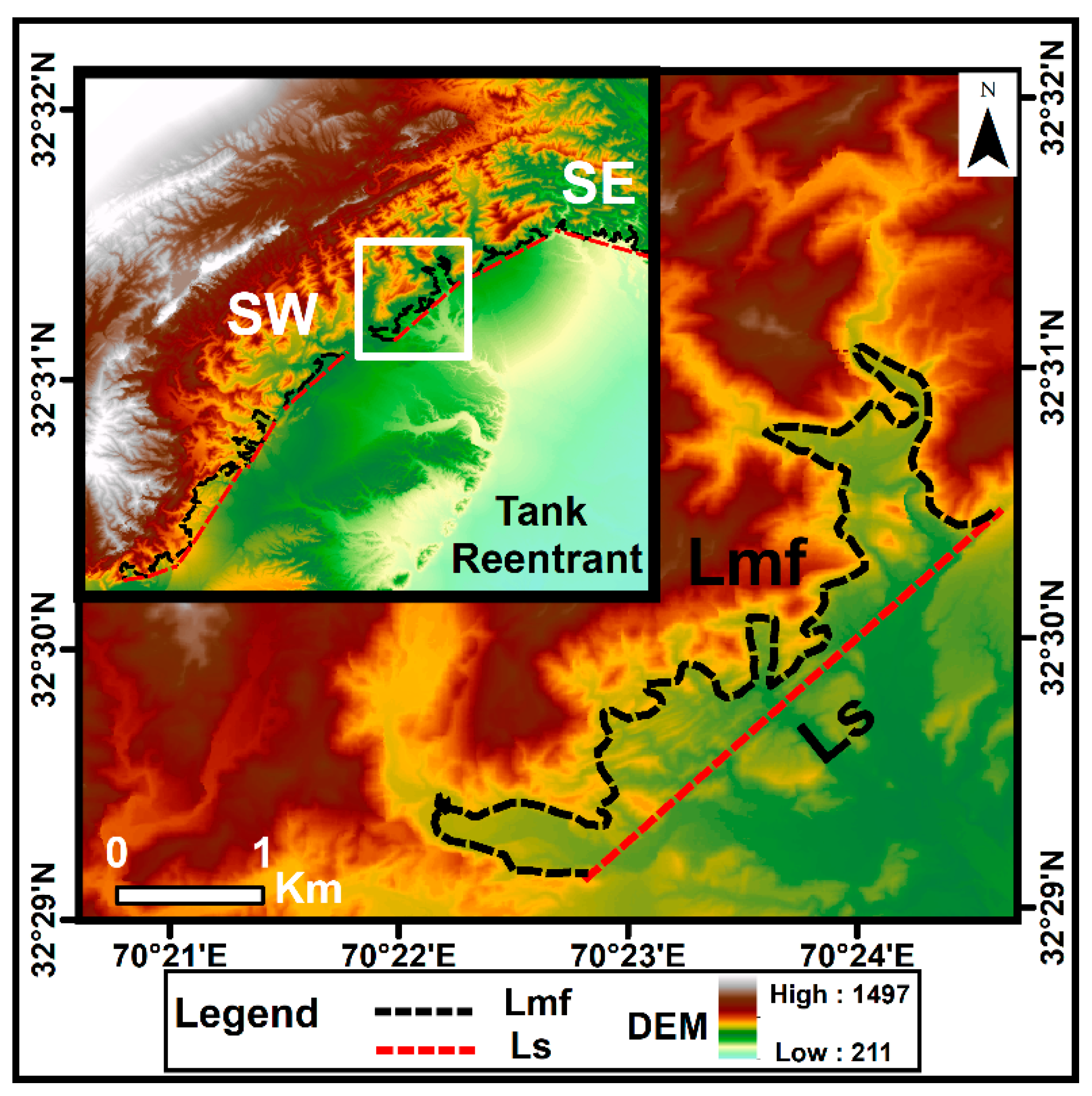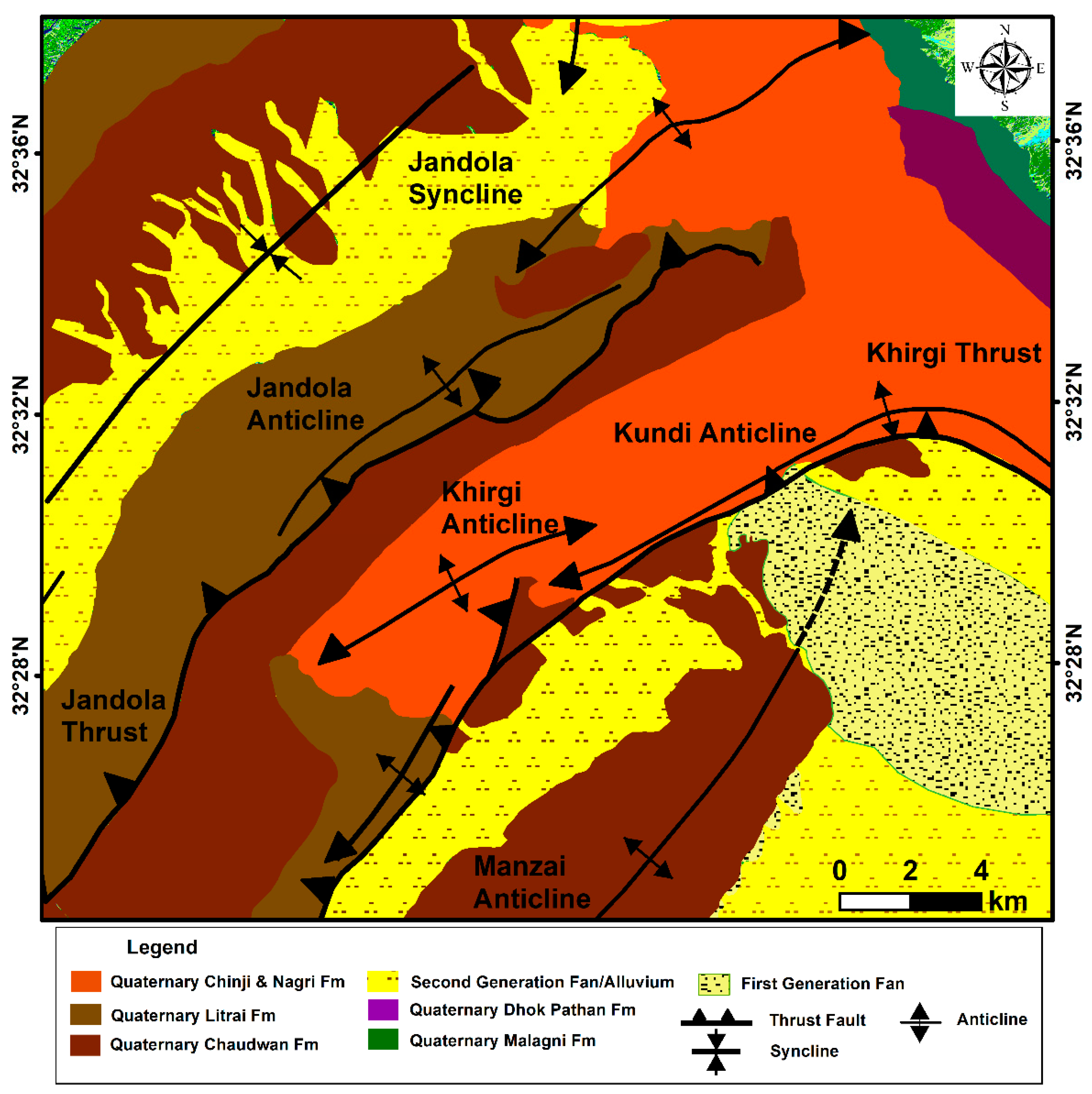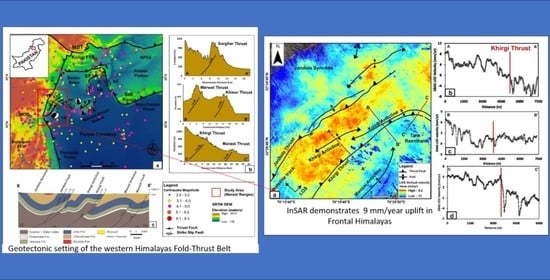Active Tectonics of the Frontal Himalayas: An Example from the Manzai Ranges in the Recess Setting, Western Pakistan
Abstract
:1. Introduction
2. Geotectonic Setting of the Study Area
3. Materials and Methods
3.1. Remote Sensing
3.2. InSAR (SBAS) Processing
3.3. Geomorphic Indices
3.3.1. Mountain Front Sinuosity (Smf)
3.3.2. Valley Floor Width to Height Ratio (Vf)
3.3.3. River Normalized Profiles
3.3.4. Channel Steepness Index
4. Results
4.1. Geological Mapping
4.2. InSAR (SBAS)
4.3. Geomorphology
4.3.1. Smf
4.3.2. Vf
4.3.3. Normalized River Profile
4.3.4. Normalized Steepness Index
5. Discussion
5.1. Relative Active Tectonics in the Manzai Ranges
5.2. Creeping Fault Segment
6. Conclusions
Supplementary Materials
Author Contributions
Funding
Acknowledgments
Conflicts of Interest
References
- Yin, A. Cenozoic tectonic evolution of the Himalayan orogen as constrained by along-strike variation of structural geometry, exhumation history, and foreland sedimentation. Earth Sci. Rev. 2006. [Google Scholar] [CrossRef]
- Treloar, P.J.; Rex, D.C.; Guise, P.G.; Coward, M.P.; Searle, M.P.; Windley, B.F.; Petterson, M.G.; Jan, M.Q.; Luff, I.W. K-Ar and Ar-Ar geochronology of the Himalayan collision in NW Pakistan: Constraints on the timing of suturing, deformation, metamorphism and uplift. Tectonics 1989, 8, 881–909. [Google Scholar] [CrossRef]
- Zhang, P.; Shen, Z.-K.; Wang, M.; Gan, W.; Bürgmann, R.; Molnar, P.; Wang, Q.; Niu, Z.; Sun, J.; Wu, J.; et al. Continuous deformation of the Tibetan Plateau from global positioning system data. Geology 2004, 32, 809–812. [Google Scholar] [CrossRef]
- Lave, J.; Avouac, J.P. Active folding of fluvial terraces across the Siwaliks Hills, Himalayas of central Nepal. J. Geophys. Res. Solid Earth 2000, 105, 5735–5770. [Google Scholar] [CrossRef]
- Lave, J.; Yule, D.; Sapkota, S.; Basant, K.; Madden, C.; Attal, M.; Pandey, R. Evidence for a great medieval earthquake (~1100 AD) in the central Himalayas, Nepal. Science 2005, 307, 1302–1305. [Google Scholar] [CrossRef] [PubMed] [Green Version]
- Malik, J.N.; Nakata, T. Active faults and related Late Quaternary deformation along the Northwestern Himalayan Frontal Zone, India. Ann. Geophys. 2003, 46, 917–936. [Google Scholar] [CrossRef]
- Senthil, K.; Wesnousky, S.G.; Rockwell, T.K.; Briggs, R.W.; Thakur, V.C.; Jayangondaperumal, R. Palaeoseismic evidence of great surface rupture earthquakes along the Indian Himalaya. J. Geophys. Res. 2006, 111. [Google Scholar] [CrossRef]
- Burgess, W.P.; Yin, A.; Dubey, C.S.; Shen, Z.-K.; Kelty, T.K. Holocene shortening across the Main Frontal Thrust zone in the eastern Himalaya. Earth Planet. Sci. Lett. 2018, 357, 152–167. [Google Scholar] [CrossRef]
- Jaume, S.C.; Lillie, R.J. Mechanics of the Salt Range-Potwar Plateau, Pakistan: A fold-and-thrust belt underlain by evaporites. Tectonics 1988, 7, 57–71. [Google Scholar] [CrossRef]
- McDougall, J.W.; Khan, S.H. Strike-slip faulting in a foreland fold-thrust belt: The Kalabagh Fault and Western Salt Range, Pakistan. Tectonics 1990, 9, 1061–1075. [Google Scholar] [CrossRef]
- Treloar, P.J.; Coward, M.P.; Chambers, A.F.; Izatt, C.N.; Jackson, K.C. Thrust geometries, interferences and rotations in the Northwest Himalaya. Thrust Tecton. 1992, 325–342. [Google Scholar] [CrossRef]
- DiPietro, J.A.; Pogue, R.K. Tectonostratigraphic subdivisions of the Himalaya: A view from the west. Tectonics 2004, 23. [Google Scholar] [CrossRef]
- Abir, I.A.; Khan, S.D.; Ghulam, A.; Tariq, S.; Shah, M.T. Active tectonics of western Potwar Plateau-Salt Range, northern Pakistan from InSAR observations and seismic imaging. Remote Sens. Environ. 2015, 168, 265–275. [Google Scholar] [CrossRef] [Green Version]
- Jouanne, F.; Awan, A.; Pêcher, A.; Kausar, A.; Mugnier, J.-L.; Khan, I.; Khan, N.A.; Van Melle, J. Present-day deformation of northern Pakistan from Salt Ranges to Karakorum Ranges. J. Geophys. Res. Solid Earth 2014. [Google Scholar] [CrossRef]
- Khan, M.A.; Bendick, R.; Bhat, M.I.; Bilham, R.; Kakar, D.M.; Khan, S.F.; Lodhi, S.H.; Qazi, M.S.; Singh, B.; Szeliga, W.; et al. Preliminary geodetic constraints on plate boundary deformation on the western edge of the Indian plate from TriGGnet (Tri-University GPS Geodesy Network). J. Himal. Earth Sci. 2008, 41, 71–87. [Google Scholar]
- Chen, L.; Khan, S.D. InSAR observation of the strike-slip faults in the northwest Himalayan frontal thrust system. Geosphere 2010, 6, 731–736. [Google Scholar] [CrossRef]
- Khan, S.D.; Chen, L.; Ahmad, S.; Ahmad, I.; Ali, F. Lateral structural variation along the Kalabagh Fault Zone, NW Himalayan foreland fold-and-thrust belt, Pakistan. J. Asian Earth Sci. 2012, 50, 79–87. [Google Scholar] [CrossRef]
- Blisniuk, P.M.; Sonder, L.J.; Lillie, R.J. Northwest Himalayan thrust front development. Tectonics 1998, 17, 766–779. [Google Scholar] [CrossRef]
- Abir, I.A.; Khan, S.D.; Aziz, G.M.; Tariq, S. Bannu Basin, fold-and-thrust belt of northern Pakistan: Subsurface imaging and its implications for hydrocarbon exploration. Mar. Pet. Geol. 2017, 85, 242–258. [Google Scholar] [CrossRef]
- Burbank, D.W.; Raynolds, R.G.H. Stratigraphic keys to the timing of thrusting in terrestrial foreland basins: Applications to the northwestern Himalaya. In New Perspectives in Basin Analysis; Springer: Berlin/Heidelberg, Germany, 1988; p. 33151. [Google Scholar]
- Khan, M.J.; Opdyke, N.D.; Tahirkheli, R.A.K. Magnetic stratigraphy of the Siwalik group, Bhittani, Marwat and Khisor ranges, northwestern Pakistan and the timing of neogene tectonics of the Trans Indus. J. Geophys. Res. Solid Earth. 1988, 93, 11773–11790. [Google Scholar] [CrossRef]
- Munthe, J. Lithostratigraphy of fluvial deposits of late Pliocene and Pleistocene age in Bhittani and Marawat Ranges, northwestern Pakistan. In Field Conference on Neogene-Quaternary Boundary, India; Geological Survey of India Calcutta: Calcutta, India, 1981; pp. 101–105. [Google Scholar]
- Kaushal, R.K.; Singh, V.; Mukul, M.; Jain, V. Identification of deformation variability and active structures using geomorphic markers in the Nahan salient, NW Himalaya, India. Quat. Int. 2017, 462, 194–210. [Google Scholar] [CrossRef]
- Matin, A.; Mukul, M. Himalayan cross faults affect thrust sheet geometry: An example from the Munsiari thrust sheet near the Gish Transverse fault zone, frontal Darjiling Himalaya, India. J. Asian Earth Sci. 2020, 199, 104400. [Google Scholar] [CrossRef]
- Srivastava, V.; Mukul, M.; Mukul, M. Quaternary deformation in the Gorubathan recess: Insights on the structural and landscape evolution in the frontal Darjiling Himalaya. Quat. Int. 2017, 462, 138–161. [Google Scholar] [CrossRef]
- Whipple, K.X.; Shirzaei, M.; Hodges, K.V.; Arrowsmith, J.R. Active shortening within the Himalayan orogenic wedge implied by the 2015 Gorkha earthquake. Nat. Geosci. 2016, 9, 711–716. [Google Scholar] [CrossRef]
- Hemphill, W.; Kidwai, A. Stratigraphy of the Bannu and Dera Ismail Khan areas, Pakistan. U.S. Geol. Surv. Prof. 1973, 716b, 36. [Google Scholar]
- Ali, A. Structural Analysis of Trans Indus Ranges, Implications for the Hydrocarbon Potential of the NW Himalayas, Pakistan. Unpublished Ph.D. Thesis, National Center of Excellence in Geology, University of Peshawar, Peshawar, Pakistan, 2010. [Google Scholar]
- Khan, A.A. Bhittani Range, North Pakistan: The Tectonic Evolution and Hydrocarbon Prospectivity—A Geological and Geophysical Approach. Pakistan J. Hydrocarbon Res. 2012, 22, 1–11. [Google Scholar]
- Meigs, A.; Madden, C.; Yule, J.; Gavillot, Y.; Hebeler, A.; Hussain, A.; Bhat, M.; Kausar, A.; Malik, M.; Ramzan, S. Pattern, rate, and timing of surface rupturing earthquakes across the northwest Himalaya. J. Himal. Earth Sci. 2012, 45, 111–114. [Google Scholar]
- Satyabala, S.P.; Yang, Z.; Bilham, R. Stick-slip advance of the Kohat Plateau in Pakistan. Nat. Geosci. 2012, 5, 147–150. [Google Scholar] [CrossRef]
- Kazmi, A.H.; Rana, R.A. Tectonic Map of Pakistan 1: 2,000,000: Map Showing Structural Features and Tectonic Stages in Pakistan; Geological Survey of Pakistan: Quetta, Pakistan, 1982. [Google Scholar]
- Khwaja, A.A.; Lisa, M. Seismic Activity in the Western Extension of the Salt Range, Focal Mechanism Studies. J. Meteorol. 2005, 2, 35–47. [Google Scholar]
- Drusch, M.; Del Bello, U.; Carlier, S.; Colin, O.; Fernandez, V.; Gascon, F.; Hoersch, B.; Isola, C.; Laberinti, P.; Martimort, P.; et al. Sentinel-2: ESA’s Optical High-Resolution Mission for GMES Operational Services. Remote Sens. Environ. 2012, 120, 25–36. [Google Scholar] [CrossRef]
- Van Der Werff, H.; Van Der Meer, F. Sentinel-2A MSI and Landsat 8 OLI provide data continuity for geological remote sensing. Remote Sens. 2016, 8, 883. [Google Scholar] [CrossRef] [Green Version]
- Gascon, F.; Bouzinac, C.; Thépaut, O.; Jung, M.; Francesconi, B.; Louis, J.; Lonjou, V.; Lafrance, B.; Massera, S.; Gaudel-Vacaresse, A.; et al. Copernicus Sentinel-2A calibration and products validation status. Remote Sens. 2017, 9, 584. [Google Scholar] [CrossRef] [Green Version]
- Rucci, A.; Ferretti, A.; Guarnieri, A.M.; Rocca, F. Sentinel 1 SAR interferometry applications: The outlook for sub millimeter measurements. Remote Sens. Environ. 2012, 120, 156–163. [Google Scholar] [CrossRef]
- Aimaiti, Y.; Yamazaki, F.; Liu, W.; Kasimu, A. Monitoring of land-surface deformation in the Karamay oilfield, Xinjiang, China, using SAR interferometry. Appl. Sci. 2017, 7, 772. [Google Scholar] [CrossRef] [Green Version]
- Crupa, W.E.; Khan, S.D.; Huang, J.; Khan, A.S.; Kasi, A. Active tectonic deformation of the western Indian plate boundary: A case study from the Chaman Fault System. J. Asian Earth Sci. 2017, 147, 452–468. [Google Scholar] [CrossRef]
- Fattahi, H.; Amelung, F. InSAR observations of strain accumulation and fault creep along the Chaman Fault system, Pakistan and Afghanistan. Geophys. Res. Lett. 2016, 43, 8399–8406. [Google Scholar] [CrossRef] [Green Version]
- Qiu, J.; Liu, L.; Wang, C.; Wang, Y. Present-day tectonic activity along the central section of the Altyn Tagh fault derived from time series InSAR. Geodesy Geodyn. 2019, 10, 307–314. [Google Scholar] [CrossRef]
- Qu, F.; Lu, Z.; Kim, J.-W.; Zheng, W. Identify and Monitor Growth Faulting Using InSAR over Northern Greater Houston, Texas, USA. Remote. Sens. 2019, 11, 1498. [Google Scholar] [CrossRef] [Green Version]
- Miranda, N. Definition of the TOPS SLC Deramping Function for Products Generated by the S-1 IPF; European Space Agency (ESA): Paris, France, 2014. [Google Scholar]
- Wegnüller, U.; Werner, C.; Strozzi, T.; Wiesmann, A.; Frey, O.; Santoro, M. Sentinel-1 Support in the GAMMA Software. Procedia Comput. Sci. 2016, 100, 1305–1312. [Google Scholar] [CrossRef] [Green Version]
- Wells, S.; Bullard, T.; Menges, C.; Drake, P.; Karas, P.; Kelson, K.; Ritter, J.; Wesling, J. Regional variations in tectonic geomorphology along a segmented convergent plate boundary pacific coast of Costa Rica. Geomorphology 1988, 1, 239–265. [Google Scholar] [CrossRef]
- Bull, W.B. Tectonic Geomorphology of the Mojave Desert: US Geological Survey Contract Report 14-08-001-G-394; Office of Earthquakes, Volcanoes, and Engineering: Menlo Park, CA, USA, 1977; 188p. [Google Scholar]
- Goswami, P.K.; Pant, C.C.; Pandey, S. Tectonic controls on the geomorphic evolution of alluvial fans in the Piedmont Zone of Ganga Plain, Uttarakhand, India. J. Earth Syst. Sci. 2009, 118, 245–259. [Google Scholar] [CrossRef] [Green Version]
- Keller, E.A.; Pinter, N. Geomorphic Indices of Active Tectonics. In Active Tectonics: Earthquakes, Uplift, and Landscape; Prentice Hall: Upper Saddle River, NJ, USA, 1996; pp. 121–147. [Google Scholar]
- Bull, W.B. Tectonic Geomorphology of Mountains: A New Approach to Paleo-Seismology; Blackwell Publishing: Malden, MA, USA, 2007. [Google Scholar]
- Hovius, N. Macroscale process systems of mountain belt erosion. In Geomorphology and Global Tectonics; Wiley & Sons: Hoboken, NJ, USA, 2000. [Google Scholar]
- Demoulin, A. Testing the tectonic significance of some parameters of longitudinal river profiles: The case of the Ardenne (Belgium, NW Europe). Geomorphology 1998, 24, 189–208. [Google Scholar] [CrossRef]
- Holbrook, J.; Schumm, S. Geomorphic and sedimentary response of rivers to tectonic deformation: A brief review and critique of a tool for recognizing subtle epeirogenic deformation in modern and ancient settings. Tectonophysics 1999, 305, 287–306. [Google Scholar] [CrossRef]
- Strahler, A.N. Hypsometric (area-altitude) analysis of erosional topography. Geol. Soc. Am. Bull. 1952, 63, 1117–1142. [Google Scholar]
- Perron, J.T.; Royden, L. An integral approach to bedrock river profile analysis. Earth Surf. Process. Landforms 2012, 38, 570–576. [Google Scholar] [CrossRef] [Green Version]
- Kirby, E.; Whipple, K.X. Expression of active tectonics in erosional landscapes. J. Struct. Geol. 2012, 44, 54–75. [Google Scholar] [CrossRef]
- Wobus, C.; Whipple, K.X.; Kirby, E.; Snyder, N.; Johnson, J.; Spyropolou, K.; Crosby, B.; Sheehan, D. Tectonics from topography: Procedures, promise, and pitfalls. Spec. Pap. Geol. Soc. Am. 2006, 398, 55–74. [Google Scholar] [CrossRef] [Green Version]
- Andreani, L.; Gloaguen, R. Geomorphic analysis of transient landscapes in the Sierra Madre de Chiapas and Maya Mountains (northern Central America): Implications for the North American-Caribbean-Cocos plate boundary. Earth Surf. Dyn. 2016, 4, 71–102. [Google Scholar] [CrossRef] [Green Version]
- Forte, A.M.; Whipple, K.X. Short communication: The Topographic Analysis Kit (TAK) for TopoToolbox. Earth Surf. Dyn. 2019, 7, 87–95. [Google Scholar] [CrossRef] [Green Version]
- Pérez-Peña, J.; Al-Awabdeh, M.; Azañón, J.; Galve, J.P.; Booth-Rea, G.; Notti, D. SwathProfiler and NProfiler: Two new ArcGIS Add-ins for the automatic extraction of swath and normalized river profiles. Comput. Geosci. 2017, 104, 135–150. [Google Scholar] [CrossRef]
- Beck, R.A.; Burbank, D.W.; Sercombe, W.J.; Riley, G.W.; Barndt, J.K.; Berry, J.R.; Afzal, J.; Khan, A.M.; Jurgen, H.; Metje, J.; et al. Stratigraphic evidence for an early collision between northwest India and Asia. Nature 1995, 373, 55–58. [Google Scholar] [CrossRef]
- Ramsey, L.A.; Walker, R.; Jackson, J. Fold evolution and drainage development in the Zagros mountains of Fars province, SE Iran. Basin Res. 2008, 20, 23–48. [Google Scholar] [CrossRef]
- Keller, E.A.; Pinter, N. Active Tectonics: Earthquakes, Uplift, and Landscape; Princeton Hall: Hoboken, NJ, USA, 2002. [Google Scholar]
- Font, M.; Amorese, D.; Lagarde, J.-L. DEM and GIS analysis of the stream gradient index to evaluate effects of tectonics: The Normandy intraplate area (NW France). Geomorphology 2010, 119, 172–180. [Google Scholar] [CrossRef]
- Silva, P.G.; Goy, J.; Zazo, C.; Bardají, T. Fault-generated mountain fronts in southeast Spain: Geomorphologic assessment of tectonic and seismic activity. Geomorphology 2003, 50, 203–225. [Google Scholar] [CrossRef]
- Jouanne, F.; Munawar, N.; Mugnier, J.-L.; Ahmed, A.; Alam Awan, A.; Bascou, P.; Vassallo, R. Seismic coupling quantified on inferred decollements beneath the western syntaxis of the Himalaya. Tectonics 2020, 1–20. [Google Scholar] [CrossRef]










| Segment | Valley No. | Vfw (m) | Eld (m) | Erd (m) | Esc (m) | Vf | Lmf (km) | Ls (km) | Smf |
|---|---|---|---|---|---|---|---|---|---|
| Southwest | 1 | 63.5 | 621 | 653 | 535.5 | 0.63 | 9.86 | 5.8 | 1.7 |
| 2 | 82 | 612 | 600 | 516 | 0.91 | 4.91 | 3.66 | 1.34 | |
| 3 | 36 | 584.2 | 588.2 | 521 | 0.55 | 11.54 | 7.51 | 1.53 | |
| 4 | 41 | 598.5 | 580.7 | 500.5 | 0.46 | 8.47 | 4.81 | 1.76 | |
| 5 | 89.5 | 579.5 | 589 | 535 | 1.82 | 6.84 | 3.4 | 2.01 | |
| 6 | 81 | 612 | 612 | 525 | 0.93 | 4.39 | 2.42 | 1.81 | |
| 7 | 43 | 603.1 | 597.7 | 533 | 0.64 | 5.76 | 3.99 | 1.44 | |
| 8 | 32.5 | 571.5 | 558 | 512 | 0.62 | - | - | - | |
| 9 | 39.5 | 555.7 | 557.5 | 517.5 | 1.01 | - | - | - | |
| 10 | 48 | 362 | 370.9 | 310.5 | 0.86 | - | - | - | |
| Mean Vf | 0.85 | Median | 0.75 | Stand. Dev. | 0.39 | Mean Smf | 1.65 | ||
| Southeast | 1 | 86 | 479.5 | 476 | 350.5 | 0.68 | 4.84 | 2.92 | 1.66 |
| 2 | 99.5 | 510.2 | 501.2 | 386 | 0.83 | 3.52 | 2.22 | 1.59 | |
| 3 | 31 | 366.7 | 369.6 | 343.2 | 1.24 | 6.14 | 3.39 | 1.81 | |
| 4 | 19 | 326.7 | 327.5 | 315 | 1.57 | 8.28 | 4.31 | 1.92 | |
| 5 | 21 | 349.9 | 349.5 | 337.2 | 1.68 | - | - | - | |
| 6 | 28 | 339.4 | 343.1 | 326.4 | 1.89 | - | - | - | |
| 7 | 28.5 | 343.4 | 350.1 | 331.05 | 1.81 | - | - | - | |
| Mean Vf | 1.39 | Median | 1.04 | Stand. Dev. | 0.51 | Mean Smf | 1.74 |
| Fault Segments | ||
|---|---|---|
| Southwest | Southeast | |
| Mt. Front Length (km) | 31.59 | 6.98 |
| Max. Relief (m) | 1085 | 782 |
| Avg. Smf | 1.65 | 1.74 |
| Smf Range | 1.34–2.01 | 1.59–1.92 |
| Avg. Vf | 0.85 | 1.39 |
| Vf Range | 0.39–1.82 | 0.51–1.89 |
| Class | 1 | 2 |
Publisher’s Note: MDPI stays neutral with regard to jurisdictional claims in published maps and institutional affiliations. |
© 2020 by the authors. Licensee MDPI, Basel, Switzerland. This article is an open access article distributed under the terms and conditions of the Creative Commons Attribution (CC BY) license (http://creativecommons.org/licenses/by/4.0/).
Share and Cite
Qureshi, K.A.; Khan, S.D. Active Tectonics of the Frontal Himalayas: An Example from the Manzai Ranges in the Recess Setting, Western Pakistan. Remote Sens. 2020, 12, 3362. https://doi.org/10.3390/rs12203362
Qureshi KA, Khan SD. Active Tectonics of the Frontal Himalayas: An Example from the Manzai Ranges in the Recess Setting, Western Pakistan. Remote Sensing. 2020; 12(20):3362. https://doi.org/10.3390/rs12203362
Chicago/Turabian StyleQureshi, Kamil A., and Shuhab D. Khan. 2020. "Active Tectonics of the Frontal Himalayas: An Example from the Manzai Ranges in the Recess Setting, Western Pakistan" Remote Sensing 12, no. 20: 3362. https://doi.org/10.3390/rs12203362
APA StyleQureshi, K. A., & Khan, S. D. (2020). Active Tectonics of the Frontal Himalayas: An Example from the Manzai Ranges in the Recess Setting, Western Pakistan. Remote Sensing, 12(20), 3362. https://doi.org/10.3390/rs12203362






